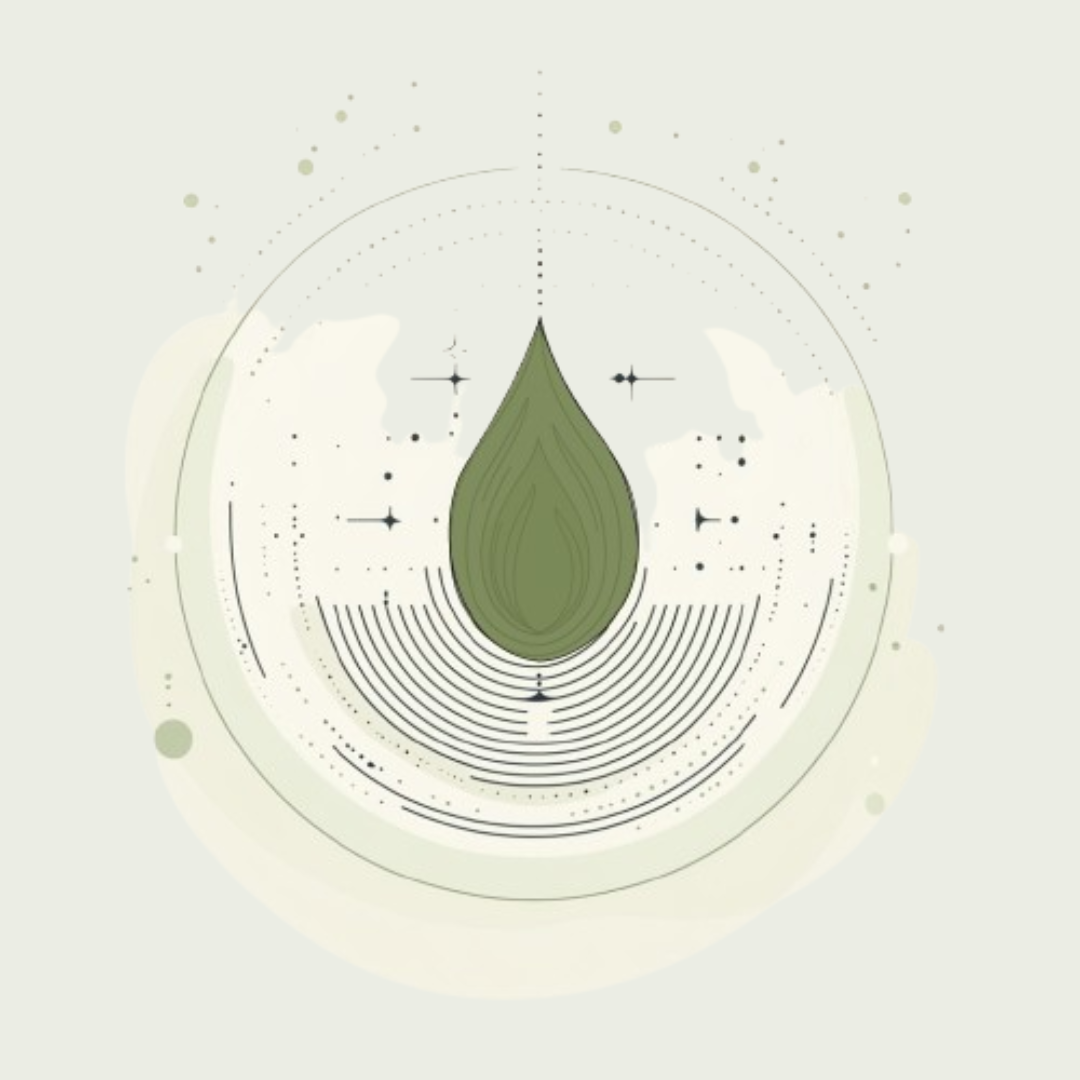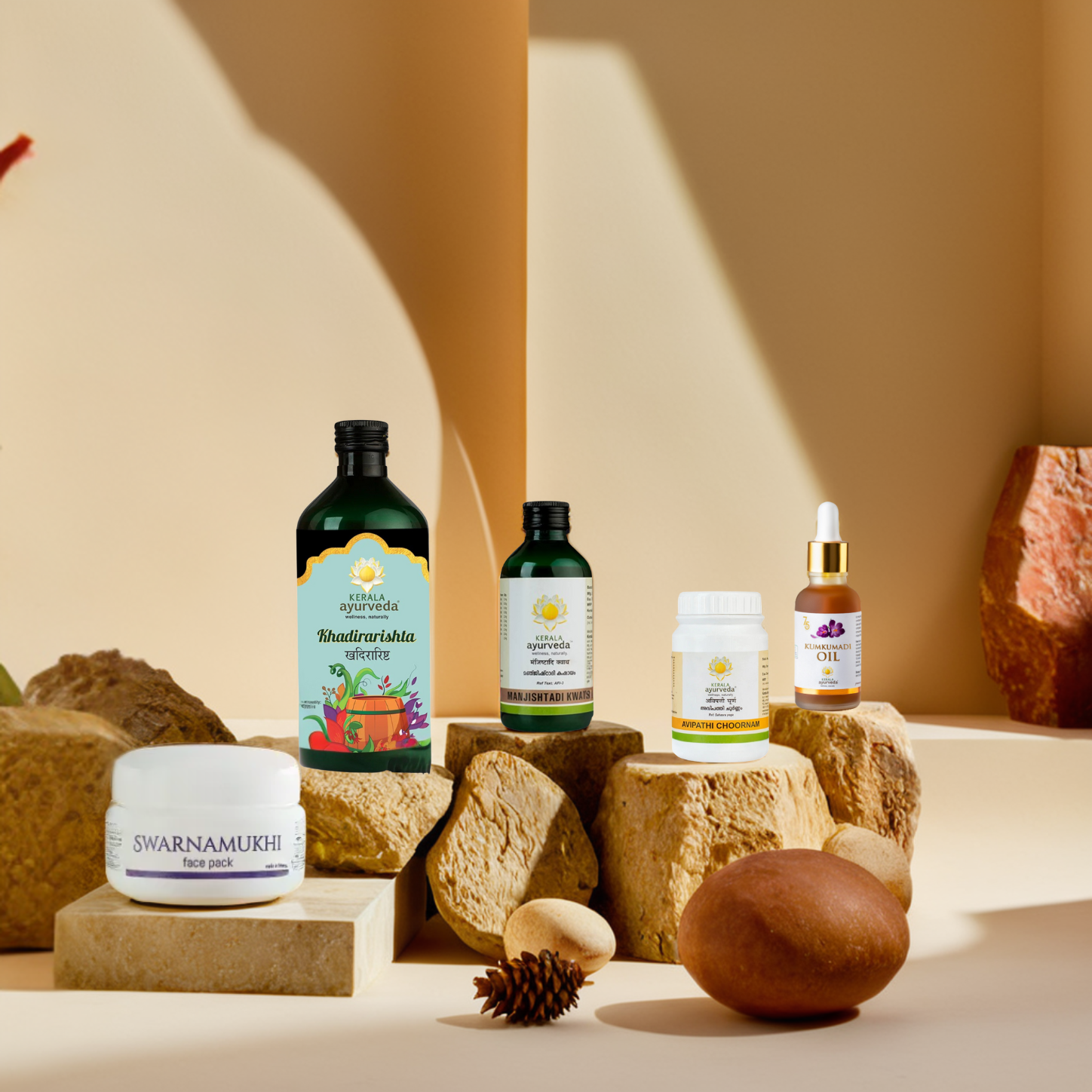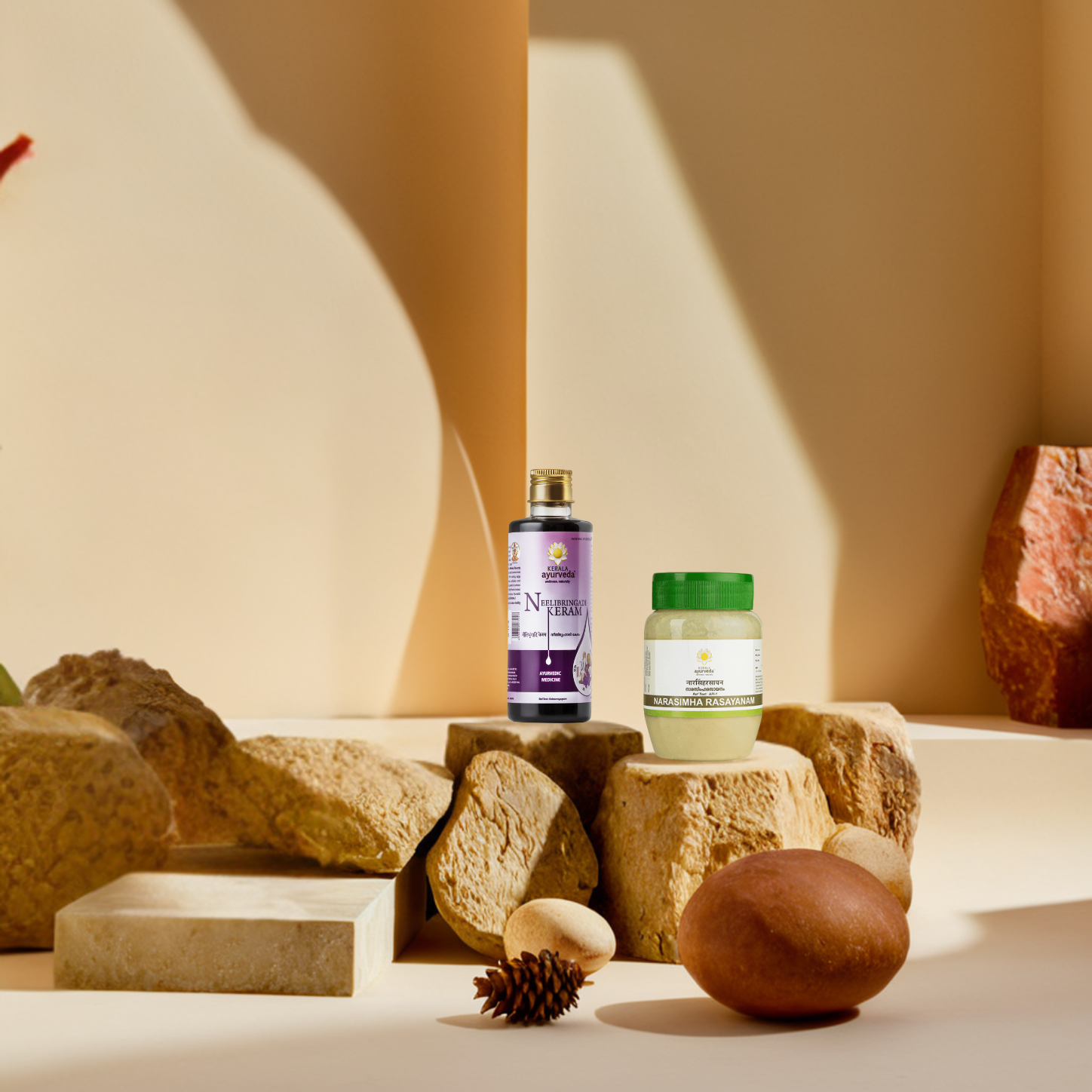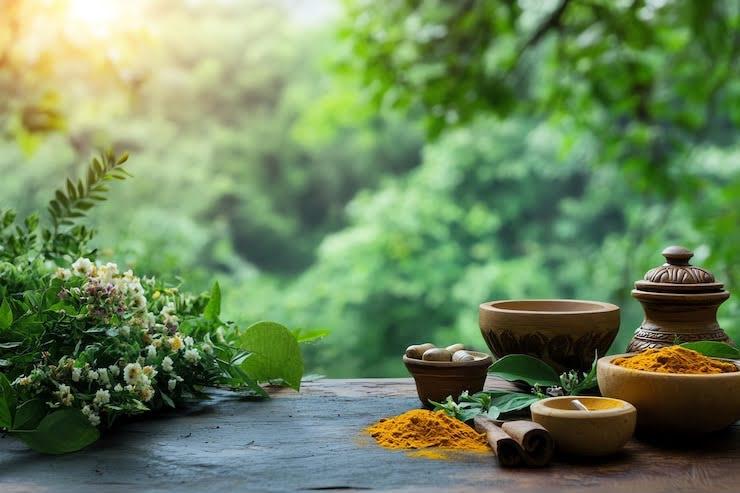Highlights
Imagine you’re constantly feeling low on energy, your digestion seems unusual, and your mood swings without warning. You’ve tried eating better, sleeping more, even cutting back on screen time, but nothing seems to click.
According to Ayurveda, everything in the universe, including our bodies, comprises the Panchamahabhoota, or five elements: space, air, fire, water, and earth. These elements don’t just exist outside in nature; they shape how we function inside, too.
At the core of Ayurveda are three energies called doshas: Vata, Pitta, and Kapha. Think of them as your body’s natural rhythms that affect how you feel physically, mentally, and emotionally.
In this blog, you’ll explore how the three doshas shape your natural balance, along with core Ayurvedic concepts like Prakriti, Dhatus, Ojas, and healing therapies like Lehyam, Thailam, Rasayana, and Panchakarma.
What is Vata?
Vata is one of the three Doshas as per Ayurveda, and it’s basically all about energy, movement, and how our nerves work. It’s made up of air and space, which makes it feel light and quick.
Vata usually gets stronger in the fall and during seasonal changes, so if you’re more Vata by nature, it’s a good idea to pay a little extra attention to your diet and lifestyle during those times to keep things balanced.
Personality Traits of Vata Type
People with a Vata type are super creative, energetic, and always full of enthusiasm. They pick up new ideas quickly, but they can forget them just as fast. They’re always on the go, staying active and alert.
Vata types usually love music and dancing, especially classical music, which helps them unwind. They also enjoy warm, soothing oil massages.
How to Spot a Vata Type Body?
Vata types usually have a frame that’s either really small or pretty broad. They tend to be more delicate but also have a muscular build, like marathon runners. Their skin can be thinner and might age faster, and they often have fuzzy hair and teeth that can be irregular.
Common Health Struggles in Vata Types
Vata types can have pretty unpredictable digestion and appetite, and skipping meals usually makes it worse. Their common health struggles include:
- Struggle with sleep due to their active and restless nature.
- Anxiety, nervousness, and a general feeling of being “off.”
- More prone to health issues like emphysema, arthritis, and pneumonia.
- Might deal with bloating, twitching, dry skin and hair, joint pain, constipation, nerve issues,
But the good news is that Vata can be brought back into balance with some simple daily habits.
Vata Balancing Tips for Daily Life
If you're a Vata type, keep your meal times regular. Avoid fasting, staying in air-conditioned spaces for too long, or overdoing intense physical activity. Being in warm and humid environments can help you stay balanced.
When it comes to food, Vata types feel their best with warm, cooked, and slightly oily meals. Keep in mind that:
- Raw, frozen, or dried veggies aren’t the best for Vata.
- Having a salad occasionally with something creamy or oily on it is perfectly fine.
- If joints feel stiff or achy, it's helpful to reduce nightshades like tomatoes, eggplants, peppers, and potatoes.
You can also consume Gandharvahasthadi Kwath to balance Vata dosha and relieve constipation. In addition, using Ksheerabala Thailam oil is helpful for balancing Vata dosha and easing your body and mind.
Of course, what works for Vata doesn’t always suit everyone. Just like Vata types need grounding, those with a dominant Pitta have unique rhythm and cooling needs.
What is Pitta?
If you're a Pitta type, you’re definitely feeling that fiery energy. Pitta is sharp, intense, and all about action. While it does have some water elements, the fire side takes the lead. It’s the part of you that controls things like metabolism, body temperature, and hormone balance.
Since Pitta plays such an important role in how your body functions, it’s no surprise that it also shapes your personality and how you approach life.
Personality Traits of Pitta Type
Pitta types are super sharp, alert, and great at focusing on tasks. They make excellent leaders, planners, and teachers because they can focus on what must be done. When it comes to money, they tend to be careful and smart with their spending.
In terms of work, they like bright, airy spaces where they can think clearly. A nice, firm massage with rose or sandalwood oil can help them unwind and calm down after a busy day.
Once you learn about the personality traits of a Pitta type, it becomes easier to recognize how these qualities show up physically.
How to Spot a Pitta Type Body?
Pitta types usually have a medium build and height. Their skin tends to be bright, sensitive, and warmer, and they usually don’t wrinkle as quickly as Vata types. While their hair can be silky, they might notice it greying or thinning earlier than others.
With a strong appetite and metabolism, Pitta types love hot spices and cold drinks. To keep things in balance, they do best with foods that are sweet, bitter, or a little dry or sharp in taste.
But their fiery energy can sometimes lead to specific health challenges when things get out of balance.
Common Health Struggles in the Pitta Body Type
Pitta types can get really angry, especially when they're hungry. Their common health struggles include:
- Hard time relaxing after concentrating on something for too long.
- Sleep can be tricky as they’re more likely to have sleep problems.
- May face issues like acne, stomach ulcers, liver issues, eczema, or other skin problems like boils.
So, it’s important to find ways to bring things back into balance.
Pitta Balancing Tips for Daily Life
If Pitta is pretty strong in someone, they should try to avoid extremes. Exercise is awesome, but it’s best to do it during the cooler parts of the day. Things like cycling, dancing, or jogging that get the body moving without overdoing it work really well.
When it comes to food, Pitta types should aim for moderation. Keep in mind :
- Big portions or overeating don’t suit Vata types.
- A vegetable-rich diet, especially with bitter-tasting veggies, works best for them.
- They should avoid foods that are overly spicy, salty, or sour.
- Occasional beer, coffee, or tea is okay, but best kept in moderation.
For keeping Pitta balanced, deep massages like shiatsu or rolfing can really do the trick. Also, consuming Drakshadi Kwath and Avipathi Choornam works wonders.
Once you get a feel for how to soothe and balance Pitta, it’s helpful to explore the qualities of Kapha, the dosha that brings its own unique energy and challenges.
What is Kapha?
Kapha is what keeps things structured and lubricated, both in your body and mind. It helps control your weight, support growth, and keep your joints and lungs nice and smooth. It’s also in charge of forming all the body’s tissues, like blood, bones, muscles, fat, and even the reproductive tissues.
Since Kapha is about keeping the body steady and well-supported, it also shapes how someone with this dosha thinks, feels, and acts.
Personality Traits of Kapha Type
Kapha types are strong, full of stamina, and have great endurance. When they’re in balance, they’re super grounded, patient, and understanding. They’re the ones who make great managers because they stay calm and handle situations well. Plus, their easygoing nature makes them fun to be around.
However, when Kapha becomes imbalanced, it may lead to overeating, avoidance of exercise, and excessive sleeping. They could also struggle with feelings like greed, possessiveness, envy, and attachment.
Once you get a sense of the personality traits that come with Kapha, it’s easier to recognize how this dosha shows up in the body, too.
How to Spot a Kapha Type Body?
Kapha types tend to have strong, well-built bodies with good muscle definition. Their skin is usually thick, oily, and smooth. They often have a calm, steady presence and don’t get tired easily. Because of their natural strength and stamina, they’re usually physically and emotionally strong. However, a few health challenges tend to come up more often for them.
Common Health Struggles in Kapha Body Type
If Kapha is out of balance for a while, people with a dominant Kapha might deal with some health issues like:
- Facing Obesity, depression, diabetes, and kidney problems.
- Catching colds, getting congested, or having sinus issues.
- Feeling sluggish, dealing with water retention, or getting headaches more often.
When Kapha gets a bit out of balance, it can lead to some frustrating health issues and low energy. Luckily, there are simple ways to bring that balance back.
Kapha Balancing Tips for Daily Life
Kapha types can stay healthy and strong for a long time if they make exercise a regular thing and mix up their routine, like changing jobs or even moving to a new place now and then. Also, it's a good idea to skip those afternoon naps and do something more exciting instead.
When it comes to food, Kapha types should keep certain things in mind. They should:
- Try to avoid dairy, fried, or greasy foods.
- Stick to vegetables that grow above the ground, like leafy greens.
- Can eat chicken, eggs, seafood, and even rabbit.
- Consume legumes, as they are a better option and lower in fat than meat.
- Take spices, especially ginger and garlic.
While Kapha types aren't as easily affected by tobacco and alcohol as the other doshas, wine is a better option if they choose to drink. Also, consuming Tuss Nil Syrup and Punarnavadi Kwath helps relieve Kapha imbalance.
Knowing how certain spices and drinks affect Kapha is like getting a sneak peek into how Ayurveda understands our natural makeup. But to really get the full picture, it helps to know about Prakriti.
Understanding Prakriti and Your Ayurvedic Body Type from Birth
In Ayurveda, Prakriti is your natural body type, the way you're built right from birth, and it stays with you for life. Ayurveda focuses on this overall balance rather than just treating symptoms to help you live your healthiest, most balanced life.
Everyone falls into one of three main Prakriti types: Vata, Pitta, or Kapha, or a mix of two, which is actually the most common and is called Dwandvaja Prakriti. According to Ayurveda, real health happens when your doshas, senses, and mind are all working in harmony.
A few key factors influence your Prakriti:
- Sukra-Shonit Prakriti: The condition of the sperm and ovum.
- Kala-garbhasaya Prakriti: The state of the uterus.
- Matu-ahar Prakriti: The food the mom ate while pregnant.
Ayurveda also breaks down Prakriti into seven types. These are based on how the three doshas appear in your body and mind. Here's a quick look:
- Monotypes: One Dosha (Vata, Pitta, or Kapha) dominates your constitution.
- Dual types: Two Doshas combined, like Vata-Pitta, Pitta-Kapha, or Kapha-Vata.
- Equal types: You’ve got equal amounts of Vata, Pitta, and Kapha in you.
Once you get a sense of your Prakriti, it becomes easier to see how those doshas actually play out in your body and mind every day.
How Do Doshas Influence Your Body and Mind?
In Ayurveda, there are three main energies, or Doshas: Vata, Pitta, and Kapha. Each of us has our own unique mix of these Doshas, and they shape how our mind and body function.
These Doshas are made up of five basic elements: ether, air, fire, water, and earth. While these elements connect everyone, they show up differently in each Dosha, which is why we’re all so unique.
Vata is a mix of space and air, Pitta is made of fire and water, and Kapha combines water and earth. Always remember that:
- Living in harmony with our natural traits helps keep the Doshas balanced.
- Going against our nature or falling into unhealthy habits can disrupt this balance.
- When Doshas go out of balance, it can lead to physical or mental health issues.
To stay healthy, it’s important to keep your Doshas close to how they were at birth; this is your Prakriti. If they drift too far from that, it creates an imbalance, called Vikruti. There are three main states:
- Balanced (everything’s in harmony)
- Increased (one Dosha is too strong)
- Decreased (one Dosha is too weak).
Figuring out which Dosha is most dominant in you can really help. The more you know, the easier it is to spot when something feels out of balance and take action.
Once you start recognizing your dominant Dosha and how it influences you, it’s natural to wonder how all the different parts of your body come together and stay strong.
What Are the 7 Dhatus and How Do They Build the Body?
Dhatus are basically the building blocks of our body. There are seven of them, each responsible for a different part of our body and its functions. These Dhatus are formed from each other, and they all get nourishment from what we digest.
Here’s a quick look at each one:
- Rasa (plasma): This is the first building block and forms the foundation of our body. It's made up of fluids that nourish the blood.
- Rakta (blood): Rasa turns into Rakta, or blood, which circulates through the body, giving oxygen and nutrients to every cell. It also helps with gas exchange and keeps us alive.
- Mamsa (muscles): Mamsa makes up our muscles and internal organs. It comes from Rasa and Rakta. You can think of it as the muscle tissue, whether it’s heart muscle, smooth muscle, or skeletal muscle.
- Medas (fat): Meda is the fatty tissue in our body that helps lubricate our organs. It also makes up parts of the brain, spinal cord, and nervous system, and keeps our body temperature steady.
- Asthi (bones): Asthi forms the bones in our body, giving us structure and support. It’s the most solid of all the Dhatus.
- Majja (marrow): Majja is the bone marrow, found inside the bones, brain, and spinal cord. It’s semi-solid and comes in yellow or red.
- Shukra (reproductive tissue): Shukra is the most refined Dhatu and is all about the reproductive tissues in the body.
Each of these Dhatus works together to keep everything running smoothly, and they all rely on what we digest to stay healthy. Since these Dhatus depend so much on what we digest to stay balanced and healthy, it makes sense to look at some of the special Ayurvedic preparations that support overall wellness.
What Is Lehyam and How Is It Used as per Ayurveda?
Lehyams are a type of Ayurvedic medicine made by mixing ingredients like sugar or jaggery, herbal powders, herbal pulp, and decoctions. They have a thick, semi-solid texture, which is created by boiling everything together with the right amount of liquid. After it cools down, honey is added to keep all the herbs’ benefits intact.
Lehyams are commonly used to treat coughs, asthma, skin problems, and arthritis. The usual dose for adults is around 10 to 15 grams. Some special Lehyams, like Agasthya Rasayanam and Chyavanaprasam, are known for rejuvenating and refreshing the body.
Just like Lehyams, another important Ayurvedic preparation is Thailam.
What Is Thailam and How Are Herbal Oils Made?
Thailam is a type of Ayurvedic oil that helps nourish the skin, relax muscles, and balance the doshas, promoting overall health and healing. It is made by heating a herbal paste with a special liquid in an oil base. Once it’s ready, the oil is filtered and stored in containers like glass or plastic jars. Here’s how it usually comes together:
- Base oil (Sneha Dravya): Usually, sesame oil is used as the base.
- Liquid media (Drava Dravya): This is usually herbal juice or a decoction, sometimes both.
- Gandha Dravya: Sometimes, a natural fragrance is added to give it a nice smell.
Fresh ingredients are important to make the best Thailam, and any dried herbs used for the decoction shouldn’t be older than six months. The general mix is about four parts oil, one part herbal paste, and 16 parts liquid, but this can change depending on the specific recipe.
Some special thailams like Balaswagandhadi Thailam improve muscle and joint strength. Also, Dhanwantharam Thailam helps strengthen abdominal muscles to facilitate easy childbirth.
While Thailams work to nourish and protect the body externally, there’s another vital energy called Ojas that supports your health and immunity from within.
How Does Ojas Support Health and Immunity?
A big part of Ayurveda is all about building and keeping your Ojas strong. Think of Ojas as the energy that keeps you healthy, strong, happy, and emotionally balanced, kind of like your body’s secret weapon for feeling your best.
To boost and protect your Ojas, eat a pure, sattvic diet, meditate, and keep things balanced in all parts of your life. Since Ojas is said to live in the heart, doing heart-opening yoga poses is a great way to give it a little extra love.
Your Ojas mostly comes from eating nourishing food that your body can digest easily. This turns into clean, energizing fuel. However, when digestion becomes weak, toxins called ama accumulate and block the process. When Ama piles up, it slows down your energy flow and keeps Ojas from doing its job.
Since Ojas plays such a big role in keeping us healthy and balanced, it’s no surprise that Ayurveda offers special therapies to boost and preserve this vital energy. Rasayana therapy is one important way to support a long, vibrant life.
How Does Rasayana Therapy Promote Rejuvenation and Longevity?
Rasayana comes from two words: ‘Rasa’, which means essence, and ‘Ayana’, which means path. So, Rasayana is all about "the path of essence." In Ayurveda, Rasayana is all about staying healthy, living longer, and slowing down aging, mostly using herbal remedies.
Ayurveda, yoga, and Rasayana all work together to keep you feeling good in your body, mind, and spirit. There are two types of Rasayana:
- Behavioral Rasayana: Balances your mind and spirit through things like eating sattvic foods, practicing yoga and meditation, and living with positive habits like honesty and kindness.
- Herbal Rasayana: Uses a blend of 10 to 20 herbs, fruits, and minerals to enhance your overall well-being.
There are two main types of herbal rasayana: Kamya rasayana, which helps improve lifestyle and energy, and Nimittika rasayana, which focuses on fighting diseases.
Kamya Rasayana is broken down further into three types:
- Pranakamya: Helps boost your energy.
- Srikamya: Gives your skin a healthy glow.
- Medhakamya: Supports better intelligence and brain function.
Together, these therapies help you feel younger, stronger, and more balanced. Rasayana therapy helps build strength and vitality over time, but sometimes our body needs a deeper reset to clear out toxins and restore balance. That’s where Panchakarma detox comes in.
What Is Panchakarma Detox and How Does It Heal & Restore Balance?
Panchkarma is a Sanskrit term that means "five actions" or "five treatments." These treatments focus on getting rid of the toxins that build up in our bodies from things like poor food choices, stress, and the environment. It detoxifies the body and is also a great way to boost your immune system and feel more refreshed.
While our bodies can naturally eliminate toxins, poor habits and stress can throw off that balance. That’s where Panchkarma comes in; it helps eliminate those toxins and restore balance. It’s actually a really relaxing experience. The treatments include things like:
- Abhyanga: A warm oil massage that relaxes your muscles and calms your mind using oils like Sahacharadi Thailam and Dhanwantharam Thailam.
- Swedana: Herbal steam therapy that opens up your body’s channels and helps with detox.
- Lymphatic massage: Boosts circulation and helps flush out toxins.
- Basti: Herbal enemas that cleanse the colon and improve digestion.
- Nasya: Nasal treatments that clear and nourish your head and sinuses.
Other treatments include Shirodhara (where warm oil is poured on the head), Garshana (a dry massage), Udvartana (an herbal powder massage), and Pinda Swedana (a warm herb-filled poultice therapy).
Overall, Panchkarma is a great way to remove toxins (Ama) from your body and regain your health and energy.
Conclusion
Ayurveda is more than just a bunch of remedies; it’s a timeless way to understand why you feel the way you do and how to bring yourself back into balance. Once you get to know your unique Prakriti (your natural makeup) and how the Vata, Pitta, and Kapha doshas work in your body, Ayurveda hands you the tools to take control of your health.
What’s great about Ayurveda is that it’s all about you. It doesn’t try to put everyone in the same box. Instead, it celebrates what makes you unique and offers simple lifestyle and food tips to help you feel your best, naturally, from day one and every step along the way.
That’s why Kerala Ayurveda focuses on personalized care, offering trusted products and easy tips that honor your unique body and mind. Start your journey to feeling balanced and healthy naturally, every day, just for you.
FAQs
1. What are the four pillars of Ayurveda?
The four pillars of Ayurveda include Vaidya (Physician/Doctor), Aushodhi (Medicine/Medication), Paricharak (Nursing Staff), and Rogi (Patient).
2. What is done in Panchakarma treatment?
Panchakarma includes five main cleansing steps that help remove toxins from the body. These usually involve therapies like oil massages (Abhyanga), herbal steam, gentle purgation to cleanse the gut, nasal detox (Nasya), and enemas using herbal oils or decoctions (Basti). The whole process is personalized based on your body type and health needs.
3. What happens when Vata dosha is imbalanced?
When Vata is out of balance, it can show up as unexpected weight loss, joint pain like arthritis, weak bones, low immunity, or an irregular digestion pattern. People with Vata imbalance often feel anxious, nervous, or restless, both in body and mind.





